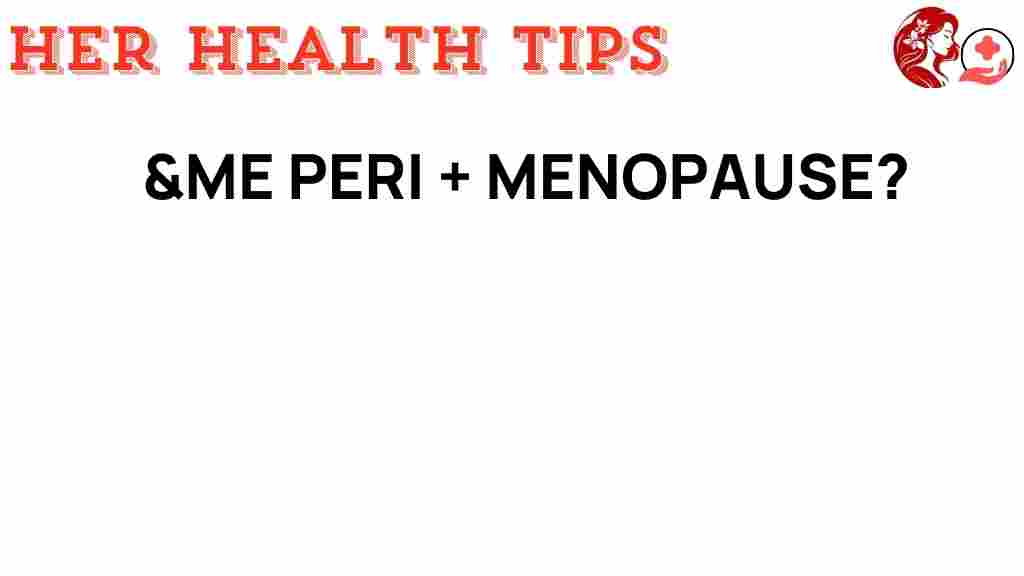Unlocking the Mysteries of Perimenopause
Perimenopause is a significant phase in a woman’s life that marks the transition toward menopause. Understanding this period is crucial for women’s health, as it brings about various hormonal changes that can affect overall well-being. In this article, we will explore the nuances of perimenopause, the symptoms associated with it, and strategies to manage wellness during this transition. By increasing awareness of perimenopause, women can better navigate this age-related phase of reproductive health.
Understanding Perimenopause
Perimenopause is the time leading up to menopause, which typically occurs in a woman’s late 40s to early 50s. This phase can last several years and is characterized by fluctuating hormone levels, particularly estrogen and progesterone. These hormonal changes can lead to various symptoms that affect physical, emotional, and mental health.
What are the Symptoms of Perimenopause?
The symptoms of perimenopause can vary widely among women, but some common signs include:
- Irregular Menstrual Cycles: Changes in the frequency and intensity of periods.
- Hot Flashes: Sudden feelings of warmth, often accompanied by sweating.
- Night Sweats: Episodes of sweating during sleep that can disrupt rest.
- Sleep Disturbances: Difficulty falling asleep or staying asleep.
- Mood Changes: Increased irritability, anxiety, or depression.
- Weight Gain: Changes in metabolism can lead to weight gain, particularly around the abdomen.
- Vaginal Dryness: Decreased lubrication can lead to discomfort during intercourse.
- Memory Issues: Difficulty concentrating or forgetfulness, often referred to as “brain fog.”
Recognizing these symptoms early can help women prepare and seek appropriate support for their reproductive health during this transitional phase.
The Importance of Awareness and Education
Awareness of perimenopause is essential in promoting women’s health. Unfortunately, many women are unaware of this phase and its implications. Increased education about perimenopause can empower women to seek help, share their experiences, and make informed decisions regarding their health. Knowing what to expect can alleviate anxiety and promote proactive management of symptoms.
Managing Perimenopause: A Step-by-Step Guide
Managing perimenopause involves a holistic approach that includes lifestyle modifications, wellness strategies, and medical interventions when necessary. Here’s a step-by-step guide to navigate this transition effectively:
Step 1: Embrace a Healthy Lifestyle
Adopting a healthy lifestyle can significantly impact how you experience perimenopause. Consider the following:
- Balanced Diet: Focus on a diet rich in fruits, vegetables, whole grains, and lean proteins. Foods high in phytoestrogens, such as soy products, can help balance hormones.
- Regular Exercise: Engaging in physical activity can help manage weight, reduce stress, and improve mood. Aim for at least 150 minutes of moderate aerobic activity each week.
- Stay Hydrated: Drink plenty of water to help alleviate some symptoms, like dryness and bloating.
- Limit Caffeine and Alcohol: Both can exacerbate hot flashes and disrupt sleep patterns.
Step 2: Prioritize Mental Health
Mental wellness is just as important as physical health during perimenopause. Here are some strategies:
- Meditation and Mindfulness: Practicing mindfulness can help reduce anxiety and improve emotional regulation.
- Cognitive Behavioral Therapy (CBT): This therapy can assist in managing mood swings and feelings of depression.
- Support Groups: Connecting with other women experiencing perimenopause can provide emotional support and practical tips.
Step 3: Consult Healthcare Providers
Regular check-ups with healthcare providers are essential during perimenopause. Discuss any symptoms you are experiencing and consider the following:
- Hormone Replacement Therapy (HRT): HRT may alleviate severe symptoms for some women, but it’s important to discuss the risks and benefits with your doctor.
- Medication for Mood Disorders: If you experience significant mood changes, your healthcare provider might suggest medication.
- Regular Screenings: Keep up with routine health screenings, including mammograms and bone density tests, to monitor your overall health.
Step 4: Educate Yourself and Others
Knowledge is power. Take the time to educate yourself about perimenopause and share information with friends and family. Consider attending workshops, reading books, or exploring reputable online resources. For more information on women’s health during perimenopause, visit this resource.
Troubleshooting Common Symptoms
Even with proactive management, some symptoms may persist. Here are some troubleshooting tips to alleviate common discomforts:
- Hot Flashes: Dress in layers, keep your environment cool, and consider herbal supplements such as black cohosh after consulting with a healthcare provider.
- Sleep Issues: Establish a calming bedtime routine, avoid screens before bed, and consider sleep aids if necessary.
- Weight Gain: Track your dietary intake and increase your physical activity to help manage weight effectively.
- Vaginal Dryness: Use water-based lubricants during intimacy and talk to your doctor about vaginal moisturizers or HRT.
Conclusion: Embracing the Transition
Perimenopause is a natural, age-related phase of women’s health that involves significant hormonal changes and various symptoms. By unlocking the mysteries of perimenopause through awareness, education, and proactive management, women can navigate this period with confidence and grace. Embracing a healthy lifestyle, prioritizing mental wellness, and seeking support from healthcare providers are vital steps in ensuring well-being during this transition.
Remember, you are not alone in this journey. Every woman experiences perimenopause differently, and sharing your experiences can help foster a supportive community. For more insights into women’s health and wellness, explore our other articles on this topic. Together, we can empower each other to lead healthier, happier lives.
This article is in the category Reproductive and created by HerHealthTips Team
